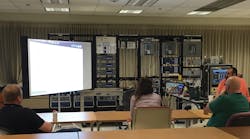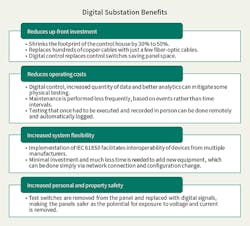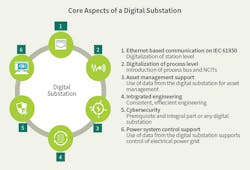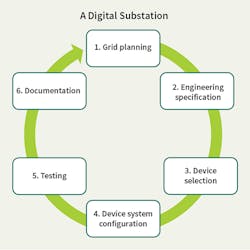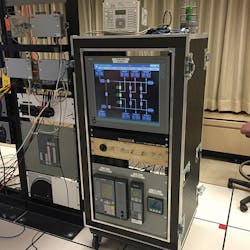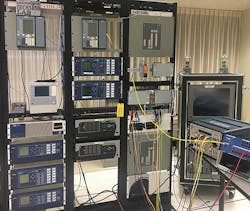National Grid is not the first utility to adopt IEC 61850 standards to modernize its substations. However, it is the first to digitize its transmission substations fully as part of a strategy to develop a highly intelligent transmission network that can meet customers’ long-term needs and adapt to the rapidly changing energy landscape.
“We’ve spent the past several decades building a reliable transmission network for our customers and communities,” said Rudy Wynter, president and COO of National Grid’s Federal Energy Regulatory Commission (FERC) regulated businesses. “Now, as we look to the future and the evolving needs of our customers and policymakers, we must invest in and create the grid that will enable the decarbonized, distributed energy future — safely, reliably and affordably. This is an example of how we are doing that.”
Substation Automation
IEC 61850 is acknowledged as the global communications standard that enables increased control, monitoring and automation within electrical power systems. In the electric transmission network, substations act as hubs, and within a substation, the protection and control (P&C) system is the neural center controlling the flow of power. Reliable P&C systems are essential to ensure a dependable and secure power system while minimizing equipment damage and loss of energy supply (load) as well as maintaining public safety.
Today’s electric networks need to become much more dynamic than they were in the past. Generation is becoming even more variable as renewable and distributed sources continue to proliferate, and the grid needs to be able to respond more quickly to rapid changes in energy flow. IEC 61850 enables automated substation operations. In turn, this creates a much more efficient transmission network that can respond in real time to these variations, thus increasing reliability. IEC 61850 and the digital substation will benefit customers with long-term cost savings, future system flexibility and increased safety.
Adapting substations to greater automation will present a challenge to the way in which utilities have traditionally operated the transmission network and maintained assets within a substation. As such, many utilities are taking a measured approach to adopting the technology by partially digitizing substations or phasing in digitalization over time at each facility.
National Grid believes the benefits of fully digitizing substations outweigh the challenges, and the approach to operations and asset management must change to enable the grid to continue delivering electricity safely, reliably and affordably as the shift to decarbonized and distributed energy sources continues. Therefore, the decision was made to digitalize the entire IEC 61850 substation using the process bus, which includes all the equipment at a substation, such as instrument transformers and circuit breakers. This goes beyond many other utilities’ IEC 61850 programs, which are reserved to the station bus, which is the communication between relays in the control house.
“We believe in IEC 61850’s decisive value proposition for customers, which is why we’re taking a comprehensive, long view in our investment strategy and made the decision to fully digitize our transmission substations,” said Chris Kelly, National Grid senior vice president of electric process and engineering.
Deployment Approach
Many of the costs and challenges associated with adopting IEC 61850 are common to those of new technologies, including transitioning the organization, its systems and its processes. By leaving execution in the hands of a legacy operations team, decisions are delayed or made with only the immediate cost and benefit in mind, slowing the transition. Moreover, by taking a piecemeal approach to upgrading equipment — especially in the context of the transition from analog to digital equipment — benefits may not be quickly or fully realized for customers. By embracing the development cost of a fully digital substation for items such as training and new standards, both the transition time and total cost can be reduced.
To mitigate these challenges as part of the transition to IEC 61850, National Grid also took a holistic approach to carving out a team and the necessary processes and standards devoted to and optimized for transforming its business for fully digital substation capability.
This transition strategy includes the following key features:
• A dedicated agile team
• A comprehensive long view that includes the full digitization of each facility
• Partnering with a trusted technology advisor and future-proofing through collaboration
• Establishment of appropriate design standards from the top down
• Process and workforce training.
The digital substation includes not only the new technology but also engineering, construction, and operations and maintenance throughout the substation life cycle. In fact, IEC 61850 and the digital substation will enable more proactive condition-based maintenance procedures, where systems are monitored continually, data is collected and maintenance can be conducted in a more prescribed manner. This is much different from the current approach, where potential issues can be hard to find and all devices must be inspected on a frequent, regular basis to determine when maintenance is required.
The Team
At the outset, National Grid established a dedicated team with the full gamut of utility engineering expertise needed to formulate a comprehensive digital strategy, including protection, controls, substation and telecommunications. This group was empowered to take an objective long view on the most appropriate deployment strategy — even if it departed from the existing decades-old playbook — and was given the authority and responsibility to progress the program on schedule.
The IEC 61850 group is responsible for researching technologies and applications, developing the standards, engaging various stakeholders for support and testing equipment to verify performance and functionality. Most importantly, perhaps, the team also owns training the engineering and operations groups. This is critical because buy-in from the operations and technical teams cannot be underestimated when implementing as demanding and all-encompassing of program as IEC 61850.
Engineering is important but support from construction, commissioning and operation teams all are necessary for long-term success. To address this, National Grid included these groups in the evaluation and decision-making process from the beginning. In the interest of efficiency and to expedite the process, dedicated working groups also were created to address specific topics such as switching and tagging, commissioning procedures, and human-machine interface (HMI) screen development.
The Long View
The IEC 61850 program marks a turning point for National Grid, as the digital substation will require a radical departure from its current standards and processes. To jump-start this transition in a comprehensive and efficient way, National Grid plans to place 40 fully digital substations in service in the next 10 years.
National Grid believes this aggressive schedule and comprehensive scale will enable several new technologies and programs such as enhanced asset monitoring, data analytics and workflow process improvements. Furthermore, it will also inform a more holistic and enduring approach to writing the most appropriate design standards for the digital era.
Partnering and Collaboration
To meet its goals and aggressive timeline, the National Grid team recognized the need to engage an external technology partner with deep knowledge and experience with IEC 61850 to serve as a technical advisor and systems integrator. A comprehensive and competitive request-for-proposal process led to the selection of Siemens AG, based on its strong understanding of IEC 61850 in the U.S. market, experience with the technology and alignment with National Grid’s strategic approach.
National Grid also is working with neighboring utilities to understand and learn from their experiences with the technology, develop the IEC 61850 business case and build internal support for the technology. In addition, National Grid is collaborating with other utilities to help influence manufacturers, standards committees and regulators to drive the greatest value for customers.
Appropriate Standards
As a key part of its long-term strategy, National Grid is creating a completely new set of engineering, commissioning and testing standards for P&C systems at digital substations. In the past, P&C designs were done using a bottom-up approach, where the design was dictated by the equipment available at the time. This approach did not maximize the full capability of new systems and, ultimately, would impair the advancement of National Grid’s IEC 61850 strategy.
The new National Grid IEC 61850-based standard is being developed using a top-down design that examines system requirements holistically rather than in individual sections. This way, efficiencies can be gained by meeting several requirements at once, while benefiting customers through accelerated cost savings as well as reduced design and construction time. The top-down approach enables a long-term view and optimization of the full complement of digital substation functionality, usability and security.
The utility’s top-down design also includes a comprehensive view of cybersecurity risks throughout its electricity networks and mitigating those risks head on. Movement toward digital substations does not mean the utility will compromise the security of its networks. As such, given the importance of these hazards, from day one, the future system has been designed with cybersecurity and usability in mind.
As part of creating new standards, National Grid is reexamining the entire life cycle of a digital substation to make the life cycle processes more efficient. In the past, design concepts often were rewritten multiple times, starting with a conceptual report, then placed into drawings and, finally, constructed with individual wires. With a digital substation, the conceptual report can be represented by a high-level digital system and substation configuration file.
This configuration file is made possible by IEC 61850 and contains all the P&C information for a given substation. This file is then developed further for the specific installation. Next, the digital substation project file is tested prior to and after construction. Finally, any issues are corrected in the file, setting the table for the next project. Information can be transferred seamlessly between phases and refined for future projects, reducing duplicated efforts and human error when transitioning between teams.
To expedite the top-down strategy, National Grid built two new U.S. laboratories, one in New England and another in New York, to verify device functionality, test substation project configurations before they are built, train engineers and field workforce, and assist with future troubleshooting.
Looking Ahead
To scale the project, National Grid is considering the long-term need for continuous improvement of its end-to-end (design, construction and operations) process through the engagement of its entire delivery team, including process practitioners as well as the general workforce. In addition to helping engineers and operators in the immediate term, the laboratories will provide a hands-on opportunity for change management and up-skilling of the workforce over time
When pushing the boundaries of commercially available technology, as National Grid is doing with its approach to the IEC 61850 implementation, the greatest challenge often is the unknown risks that may arise from within or outside the organization. As National Grid looks ahead to the next phase of implementation, scaling the strategy and training its core workforce, the utility’s long-term methodical approach, dedicated team and laboratory facilities will enable the team to identify any new risks and address them before they become problematic.
External collaborations with neighboring utilities is a natural extension of this approach, enabling National Grid to exchange best practices and, ultimately, share those with manufacturers and even regulators to help shape the future.
This is an exciting time in the energy industry with technologies like IEC 61850 constantly emerging and evolving. National Grid will continue to explore opportunities to leverage these innovations to create a highly intelligent, robust, resilient, flexible and secure transmission grid that delivers maximum long-term value to customers and communities. ♦
Terron Hill is director of transmission network strategy at National Grid. He is responsible for infrastructure investments on National Grid’s U.S. electric transmission grid and deployment of new innovative technologies to enable National Grid’s vision of an intelligent transmission network that facilitates the evolving needs of customers and a decarbonized energy future. Hill is a graduate of Cornell University.
Leonard G. Swanson Jr. is director of protection, C&I, IEC 61850 and telecom engineering at National Grid. He and his team provide these engineering services and set policy for them across the utility’s U.S. footprint. Swanson also is responsible for substation critical infrastructure protection compliance and analysis of all system disturbances. He holds a master’s degree in electric power engineering from Northeastern University and a BSEE degree from Gannon University. He is a registered professional engineer in Massachusetts and Pennsylvania.
Mark Thompson is the engineering manager for the IEC 61850 group at National Grid. His group is responsible for the development and rollout of IEC 61850 throughout the National Grid U.S. territory. He has more than 10 years of experience with industrial and utility power and control systems. He holds a BSEE degree from Rochester Institute of Technology and will complete a master’s degree in public administration from Syracuse University in 2018. He is a registered professional engineer in New York.
Check out the April 2018 issue for more articles, news and commentary.
